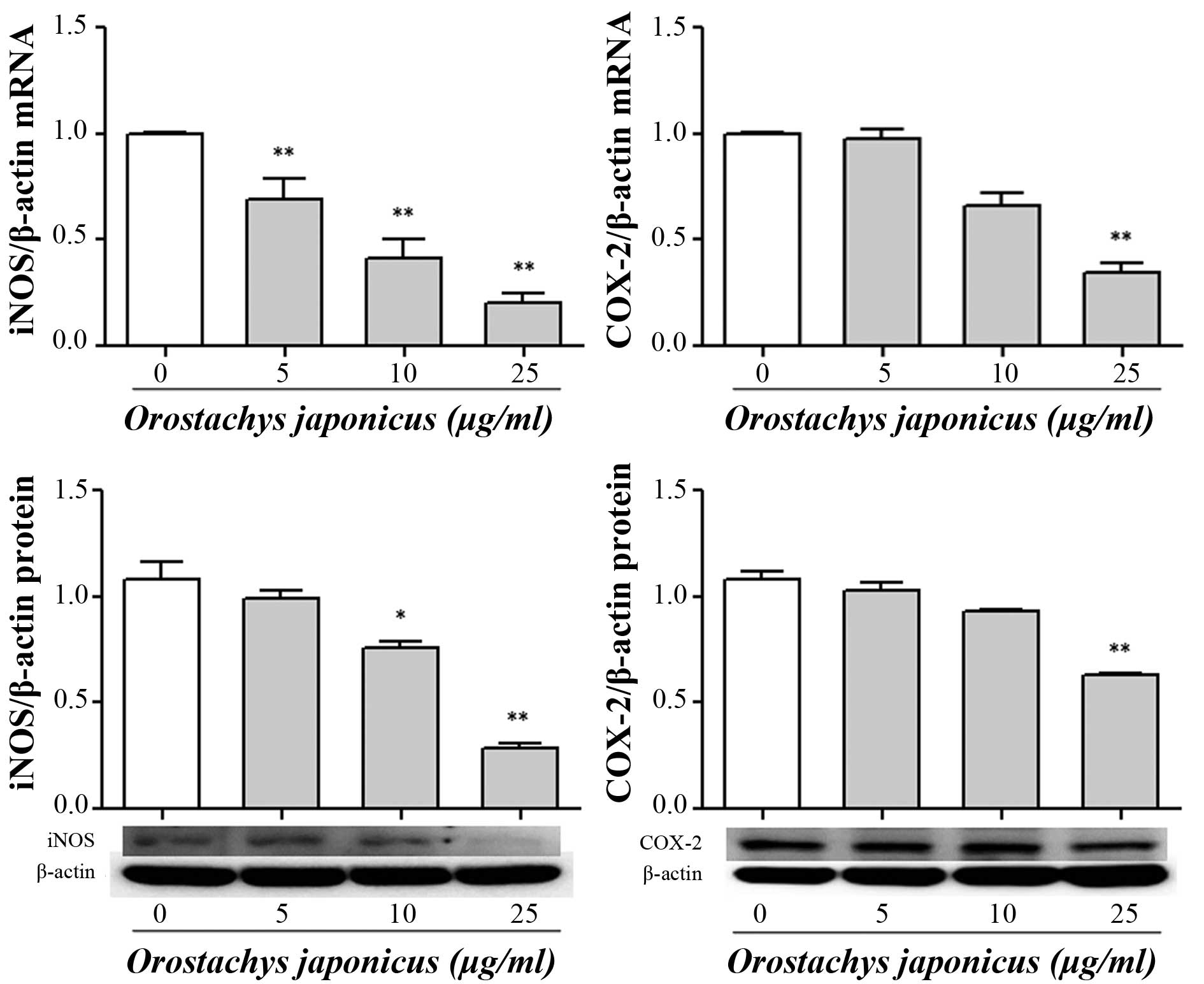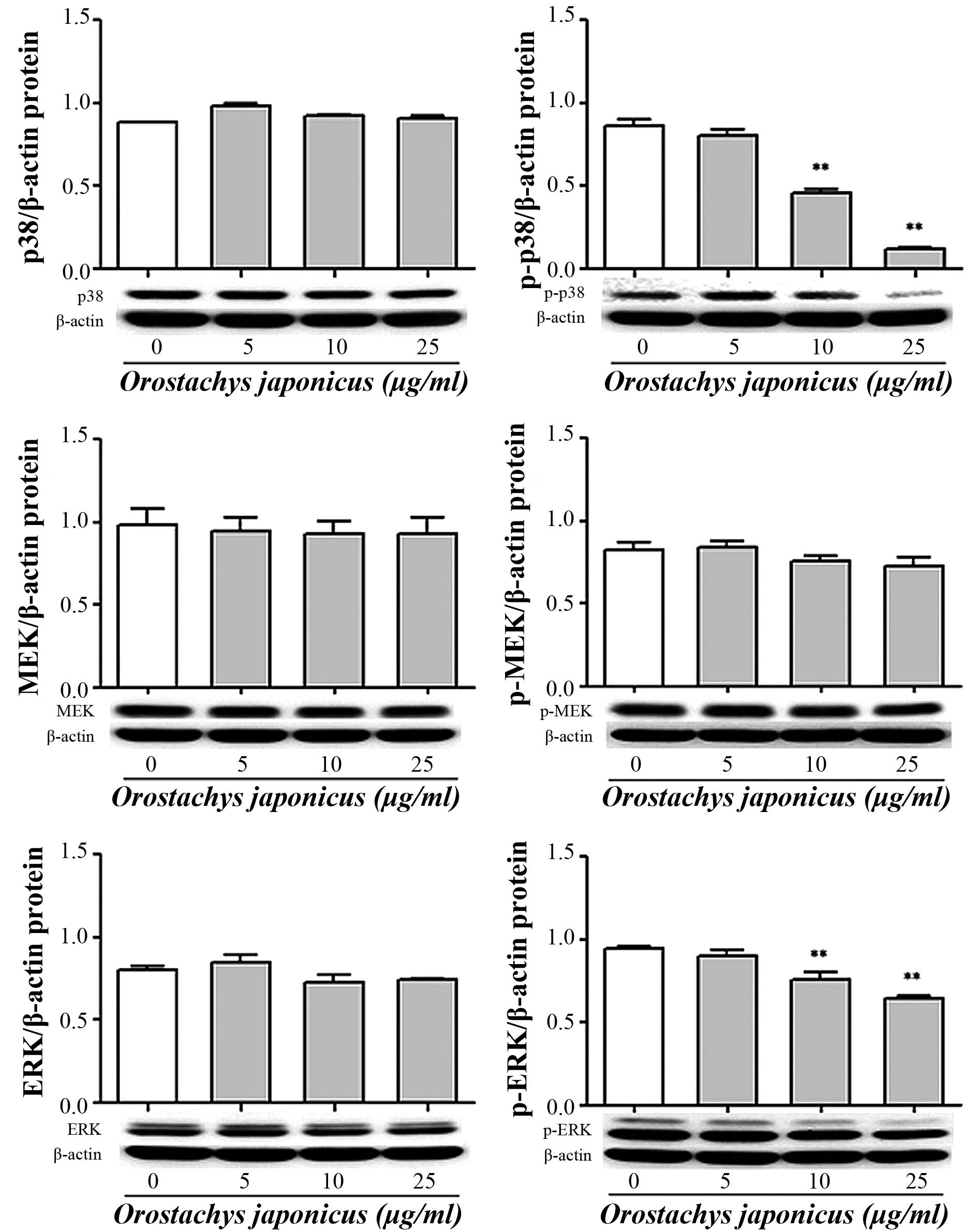|
1
|
Kim JK: Illustrated Natural Drugs
Encyclopedia. 1. 1st. Namsandang Press; Korea: pp. 14–167. 1984
|
|
2
|
Visse R and Nagase H: Matrix
metalloproteinases and tissue inhibitors of metalloproteinases:
structure, function and biochemistry. Circ Res. 92:827–839. 2003.
View Article : Google Scholar : PubMed/NCBI
|
|
3
|
Apodaca G, Rutka JT, Bouhana K, et al:
Expression of metal-loproteinases and metalloproteinase inhibitors
by fetal astrocytes and glioma cells. Cancer Res. 50:2322–2329.
1990.PubMed/NCBI
|
|
4
|
Ray JM and Stetler-Stevenson WG: The role
of matrix metal-loproteases and their inhibitors in tumour
invasion, metastasis and angiogenesis. Eur Respir J. 7:2062–2072.
1994.PubMed/NCBI
|
|
5
|
Stetler-Stevenson WG: Type IV collagenases
in tumor invasion and metastasis. Cancer Metastasis Rev. 9:289–303.
1990. View Article : Google Scholar : PubMed/NCBI
|
|
6
|
Mauviel A: Cytokine regulation of
metalloproteinase gene expression. J Cell Biochem. 53:288–295.
1993. View Article : Google Scholar : PubMed/NCBI
|
|
7
|
Di Nezza LA, Misajon A, Zhang J, et al:
Presence of active gelatinases in endometrial carcinoma and
correlation of matrix metalloproteinase expression with increasing
tumor grade and invasion. Cancer. 94:1466–1475. 2002. View Article : Google Scholar : PubMed/NCBI
|
|
8
|
Sato T, Sakai T, Noguchi Y, Takita M,
Hirakawa S and Ito A: Tumor-stromal cell contact promotes invasion
of human uterine cervical carcinoma cells by augmenting the
expression and activation of stromal matrix metalloproteinases.
Gynecol Oncol. 92:47–56. 2004. View Article : Google Scholar : PubMed/NCBI
|
|
9
|
Berube M, Deschambeault A, Boucher M,
Germain L, Petitclerc E and Guerin SL: MMP-2 expression in uveal
melanoma: differential activation status dictated by the cellular
environment. Mol Vis. 11:1101–1111. 2005.PubMed/NCBI
|
|
10
|
Cottam DW, Rennie IG, Woods K, Parsons MA,
Bunning RA and Rees RC: Gelatinolytic metalloproteinase secretion
patterns in ocular melanoma. Invest Ophthalmol Vis Sci.
33:1923–1927. 1992.PubMed/NCBI
|
|
11
|
Garzetti GG, Ciavattini A, Lucarini G, et
al: Tissue and serum metalloproteinase (MMP-2) expression in
advanced ovarian serous cystoadenocarcinomas: clinical and
prognostic implications. Anticancer Res. 15(6B): 2799–2804.
1995.PubMed/NCBI
|
|
12
|
Fishman DA, Bafetti LM, Banionis S, Kearns
AS, Chilukuri K and Stack MS: Production of extracellular
matrix-degrading proteinases by primary cultures of human
epithelial ovarian carcinoma cells. Cancer. 80:1457–1463. 1997.
View Article : Google Scholar : PubMed/NCBI
|
|
13
|
Stetler-Stevenson WG: The role of matrix
metalloproteinases in tumor invasion, metastasis and angiogenesis.
Surg Oncol Clin N Am. 10:383–392. 2001.
|
|
14
|
Smith WL and Langenbach R: Why there are
two cyclooxygenase isozymes. J Clin Invest. 107:1491–1495. 2001.
View Article : Google Scholar : PubMed/NCBI
|
|
15
|
Koki AT, Leahy KM, Harmon JM and Masferrer
JL: Cyclooxygenase-2 and cancer. COX-2 blockade in cancer
prevention and therapy. Harris RE: Humana Press; Totowa, NJ: pp.
185–203. 2003
|
|
16
|
Gallo O, Fabbroni V, Sardi I, Magnelli L,
Boddi V and Franchi A: Correlation between nitric oxide and
cyclooxygenase-2 pathways in head and neck squamous cell
carcinomas. Biochem Biophys Res Commun. 299:517–524. 2002.
View Article : Google Scholar : PubMed/NCBI
|
|
17
|
Han M, Wen JK, Zheng B and Zhang DQ:
Acetylbritannilatone suppresses NO and PGE2 synthesis in
RAW 264.7 macrophages through the inhibition of iNOS and COX-2 gene
expression. Life Sci. 75:675–684. 2004. View Article : Google Scholar : PubMed/NCBI
|
|
18
|
Cianchi F, Cortesini C, Bechi P, et al:
Up-regulation of cyclooxygenase 2 gene expression correlates with
tumor angiogenesis in human colorectal cancer. Gastroenterology.
121:1339–1347. 2001. View Article : Google Scholar : PubMed/NCBI
|
|
19
|
Cianchi F, Cortesini C, Fantappie O, et
al: Inducible nitric oxide synthase expression in human colorectal
cancer: correlation with tumor angiogenesis. Am J Pathol.
162:793–801. 2003. View Article : Google Scholar : PubMed/NCBI
|
|
20
|
Klimp AH, Hollema H, Kempinga C, van der
Zee AG, de Vries EG and Daemen T: Expression of cyclooxygenase-2
and inducible nitric oxide synthase in human ovarian tumors and
tumor-associated macrophages. Cancer Res. 61:7305–7309.
2001.PubMed/NCBI
|
|
21
|
Chiang YM, Lo CP, Chen YP, et al: Ethyl
caffeate suppresses NF-κB activation and its downstream
inflammatory mediators, iNOS, COX-2 and PGE2 in vitro or
in mouse skin. Br J Pharmacol. 146:352–363. 2005. View Article : Google Scholar : PubMed/NCBI
|
|
22
|
Chen PN, Hsieh YS, Chiang CL, Chiou HL,
Yang SF and Chu SC: Silibinin inhibits invasion of oral cancer
cells by suppressing the MAPK pathway. J Dent Res. 85:220–225.
2006. View Article : Google Scholar : PubMed/NCBI
|
|
23
|
Hsieh YS, Chu SC, Yang SF, Chen PN, Liu YC
and Lu KH: Silibinin suppresses human osteosarcoma MG-63 cell
invasion by inhibiting the ERK-dependent c-Jun/AP-1 induction of
MMP-2. Carcinogenesis. 28:977–987. 2007. View Article : Google Scholar
|
|
24
|
Weng CJ, Chau CF, Hsieh YS, Yang SF and
Yen GC: Lucidenic acid inhibits PMA-induced invasion of human
hepatoma cells through inactivating MAPK/ERK signal transduction
pathway and reducing binding activities of NF-κB and AP-1.
Carcinogenesis. 29:147–156. 2008. View Article : Google Scholar
|
|
25
|
Ou YQ, Chen LH, Li XJ, Lin ZB and Li WD:
Sinomenine influences capacity for invasion and migration in
activated human monocytic THP-1 cells by inhibiting the expression
of MMP-2, MMP-9 and CD147. Acta Pharmacol Sin. 30:435–441. 2009.
View Article : Google Scholar : PubMed/NCBI
|
|
26
|
Shin DY, Lee WS, Jung JH, et al:
Flavonoids from Orostachys japonicus A. Berger inhibit the invasion
of LnCaP prostate carcinoma cells by inactivating Akt and
modulating tight junctions. Int J Mol Sci. 14:18407–18420. 2013.
View Article : Google Scholar : PubMed/NCBI
|
|
27
|
Quaranta M, Daniele A, Coviello M, et al:
MMP-2, MMP-9, VEGF and CA 15.3 in breast cancer. Anticancer Res.
27(5B): 3593–3600. 2007.PubMed/NCBI
|
|
28
|
Ohshima H, Tazawa H, Sylla BS and Sawa T:
Prevention of human cancer by modulation of chronic inflammatory
processes. Mutat Res. 591:110–122. 2005. View Article : Google Scholar : PubMed/NCBI
|
|
29
|
Pahl HL: Activators and target genes of
Rel/NF-κB transcription factors. Oncogene. 18:6853–6866. 1999.
View Article : Google Scholar : PubMed/NCBI
|
|
30
|
Garg A and Aggarwal BB: Nuclear
transcription factor-κB as a target for cancer drug development.
Leukemia. 16:1053–1068. 2002. View Article : Google Scholar : PubMed/NCBI
|
|
31
|
Bi X, Yan B, Fang S, et al: Quetiapine
regulates neurogenesis in ischemic mice by inhibiting NF-κB p65/p50
expression. Neurol Res. 31:159–166. 2009. View Article : Google Scholar : PubMed/NCBI
|
|
32
|
Wei PL, Tu CC, Chen CH, et al: Shikonin
suppresses the migratory ability of hepatocellular carcinoma cells.
J Agric Food Chem. 61:8191–8197. 2013. View Article : Google Scholar : PubMed/NCBI
|
|
33
|
Kanangat S, Postlethwaite A, Hasty K, et
al: Induction of multiple matrix metalloproteinases in human dermal
and synovial fibroblasts by Staphylococcus aureus: implications in
the pathogenesis of septic arthritis and other soft tissue
infections. Arthritis Res Ther. 8:R1762006. View Article : Google Scholar : PubMed/NCBI
|
|
34
|
Menke NB, Ward KR, Witten TM, Bonchev DG
and Diegelmann RF: Impaired wound healing. Clin Dermatol. 25:19–25.
2007. View Article : Google Scholar : PubMed/NCBI
|
|
35
|
Kim JM, Jung HY, Lee JY, Youn J, Lee CH
and Kim KH: Mitogen-activated protein kinase and activator
protein-1 dependent signals are essential for Bacteroides fragilis
enterotoxin-induced enteritis. Eur J Immunol. 35:2648–2657. 2005.
View Article : Google Scholar : PubMed/NCBI
|
|
36
|
Liu WH and Chang LS: Caffeine induces
matrix metallopro-teinase-2 (MMP-2) and MMP-9 down-regulation in
human leukemia U937 cells via Ca2+/ROS-mediated
suppression of ERK/c-fos pathway and activation of p38 MAPK/c-jun
pathway. J Cell Physiol. 224:775–785. 2010. View Article : Google Scholar : PubMed/NCBI
|
|
37
|
Lee WR, Chung CL, Hsiao CJ, et al:
Suppression of matrix metalloproteinase-9 expression by
andrographolide in human monocytic THP-1 cells via inhibition of
NF-κB activation. Phytomedicine. 19:270–277. 2012. View Article : Google Scholar : PubMed/NCBI
|














